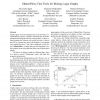Free Online Productivity Tools
i2Speak
i2Symbol
i2OCR
iTex2Img
iWeb2Print
iWeb2Shot
i2Type
iPdf2Split
iPdf2Merge
i2Bopomofo
i2Arabic
i2Style
i2Image
i2PDF
iLatex2Rtf
Sci2ools
SDM
2009
SIAM
2009
SIAM
ShatterPlots: Fast Tools for Mining Large Graphs.
Graphs appear in several settings, like social networks, recommendation systems, computer communication networks, gene/protein biological networks, among others. A deep, recurring question is “What do real graphs look like?” That is, how can we separate real ones from synthetic or real graphs with masked portions? The main contribution of this paper is ShatterPlots, a simple and powerful algorithm to extract patterns from real graphs that help us spot fake/masked graphs. The idea is to shatter a graph, by deleting edges, force it to reach a critical (“Shattering”) point, and study the properties at that point. One of the most striking patterns is the “30-per-cent”: at the Shattering point, all real and synthetic graphs have about 30% more nodes than edges. One of our most discriminative patterns is the “NodeShatteringRatio ”, which can almost perfectly separate the real graphs from the synthetic ones of our extensive collection. Additional contributions of this paper a...
| Added | 07 Mar 2010 |
| Updated | 07 Mar 2010 |
| Type | Conference |
| Year | 2009 |
| Where | SDM |
| Authors | Ana Paula Appel, Andrew Tomkins, Christos Faloutsos, Deepayan Chakrabarti, Jure Leskovec, Ravi Kumar |
Comments (0)

